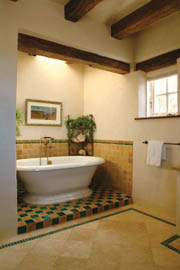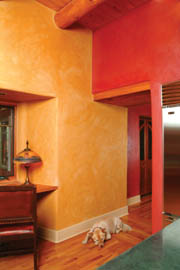
American Clay, of Santa Fe, N.M., offers a plaster-like product that is a combination of natural clays, aggregates, and pigments that create colors and textures designed as a final, decorative wall surface. Available in 30 colors, one can match any color scheme or interior décor.
Although manufactured in New Mexico, this plaster isn't just for southwestern motifs.
"The biggest crime is when people say it's just a southwestern material," says Croft Elsaesser, vice president of product development and manufacturing for American Clay. "We've had it in NYC apartments, in Colorado timber-frame-style homes with exposed frame and plaster between timbers, and European-style homes done in a very colonial style with a lot of trim molding, chair rails and crown molding. This product lends itself to many architectural styles, including the Tuscan style. And of course, the mud adobes and mud brick looks of the southwest are indeed there as well."
The company is also beginning to experiment with colored crushed glasses and aggregates to try different finishes.

Is it clay or plaster?
Referred to as an "interior clay plaster for decorative use," and "earth plaster," the product can be color integrated and is completely natural. Contractors interested in integrating it into their repertoire can purchase and play around with a small amount. The Web site, www.americanclay.com contains a great deal of information that experienced contractors could utilize for basic experimentation."For plasterers who do a lot of Venetian or lime, they have a good background of putting on thin layers and that type of thing," Elsaesser says. "Drywallers and gypsum plasterers, I can point them in the right direction through conversation, and make sure all steps are followed. They can also come to our workshop and get hands-on instruction, also offered through our distributors locations, available at our Web site."
The company offers either a half-day or a full-day workshop that includes contractor and DIYer attendees. The full-day workshop allows Elsaesser to go through the steps more thoroughly and show the consistency of the materials, and give a hands-on opportunity to show what the material does and what the limitations are. The focus of these workshops is to get drywallers who want to expand from just doing wallboard or mud work to offer clients an all-the-way-through-to-the-finish-surface under their contracts.
This material is softer than other plasters but there is a hardener that can be added, an acrylic fortifier to give it hardness. But straight from the bag, it's not that hard and therefore more recommended for lighter-traffic areas.
The clays themselves, if applied properly, are easy to touch up, are more flexible and handle more wall movement better than harder plasters that might show cracks more easily, according to Elsaesser.
"If cracks do happen because of drywall seam pops or there is substrate movement, this material is easier to repair and make seamless as opposed to having to recoat the whole wall," he adds. "In one case, I've only repaired the bottom two feet of a wall and never touched the top portion."

Application basics
To apply the material on most wallboard surfaces, a textured primer is rolled on with sand mixed in it for the clay to bond to. Traditionally, this is done with a hawk and trowel in two passes. Both passes are extremely thin at 1/16 inch or less for the finished thickness. A newer and very efficient application method is to spray on the material and trowel it back. With a gravity feed hopper or any texture sprayer, one gets fast application in terms of material on the wall."Once it's sprayed on, just back trowel it to even out the surfaces," Elsaesser explains. "We're finding that spraying cuts labor time by 30 to 50 percent. We're starting to incorporate this a little more in the classroom, too. You can get technical but depending on the equipment used, there are really not a lot of wrong ways to apply this product. The end results are about the same. It's a very forgiving coat and one can focus on textures with less concern about coverage as with other spray-on textures. Once you know the basics for the material, you can apply over any surface you have."
American Spray Technologies did some tests with its Kodiak Spray system and were very impressed with how the clay plaster flowed through the machine, according to Elsaesser. Rotor sprayers rented from Home Depot or a standard gravity feed have also worked.
Standard plaster hawk and trowel are normally the tools of choice but a lot of drywallers will use a pan and knife because they are familiar with that method. Any of these tool approaches will work. Pan and knife usually take a swimming pool trowel behind their work to smooth it out.
The twice-a-month workshops can teach contractors all that is necessary to successfully add this product to his pallet.
"Contractors have the general idea (of trowel applications) so I don't have to spend as much time with them on this and I can get into how the material goes on and spend a lot more time on the end finish steps," Elsaesser adds. "This way, they get techniques down to create different textures, effects and finishes. What they can expect is general basics that they will already have an understanding of, the general knowledge of the material and what consistency to mix it, more techniques and texture information, and how to do a final overwork of the wall so when one comes back to do touch ups, it's done seamlessly."
The half-day class is $75; the full-day class is $150 and takes place at the American Clay facility in Albuquerque. See the company's Web site for more information and for distributors that also offer classes.

Report Abusive Comment